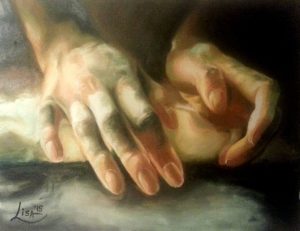 The Yogabliss, Your Heart Life on-line Moving into Meditation classes met this morning. In meditation, we focused on the experience of stillness in the body. We experienced movement of body, heart and mind in the still space of kind attention.
The Yogabliss, Your Heart Life on-line Moving into Meditation classes met this morning. In meditation, we focused on the experience of stillness in the body. We experienced movement of body, heart and mind in the still space of kind attention.
Observing how life moves through us we can know impermanence, uncertainty and also our inter-relatedness. In time and the kinship of loving awareness, we may come to know what is needed. This is how we begin to work with what we are given.
We drew inspiration from Jane Hirshfield’s poem, Rebus. The poem is from her 2002 collection, Given Sugar, Given Salt. It touches on how we respond to life and how we become our choices. It invites us to feel life’s sorrows. Our only certainty is all is subject to change. It invites us to enter life’s questions and at the same time enter each moment unadorned.
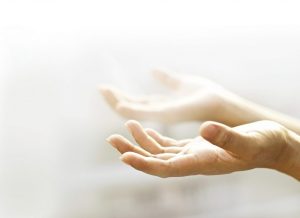 We also drew on Larry Kramer’s book, Insight Dialogue. The book offers a relational and social understanding of traditional Buddhist teachings. Insight Dialogue involves developing mindfulness and tranquility together. Students reflect on present moment experience with guidance from a topic such as change, kindness, death, or doubt. You can learn more about this relational practice at Larry’s web-site.
We also drew on Larry Kramer’s book, Insight Dialogue. The book offers a relational and social understanding of traditional Buddhist teachings. Insight Dialogue involves developing mindfulness and tranquility together. Students reflect on present moment experience with guidance from a topic such as change, kindness, death, or doubt. You can learn more about this relational practice at Larry’s web-site.
We ended with a from Alla Bozarth’s book, Lifelines: Threads of Grace through Seasons of Change. Alla is a poet, Episcopal priest and “soul caregiver.”
In practice, we can stretch time and enter stillness. How is your body making itself known to you? Can you notice a sense of settling? Begin to notice the experience of stillness in the body. Rest. Notice the body steadying itself. It may be a slow gradual shifting into stillness. Notice the qualities of stillness. There may be emotions or thoughts – can they, too, soften into the background as the experience of stillness comes forward? If you’re unable to touch into stillness this way, that’s o.k.
Perhaps you can imagine the qualities of a mountain, a majestic tree. What might signify abiding calm for you?
There is movement as well as stillness in the body. You can sense the movement of breathing. Feel the pulses of inhaling and then exhaling. The breath is moving through the stillness of the body. Can you feel stillness and movement? Let body and breath be known. Let stillness and movement be known. Notice how your body is experiencing calm and ease however small. Bring your full awareness to the experience of calm. If this is difficult or creating tension – take a deeper breath and let it go. Relax your mind if you can.
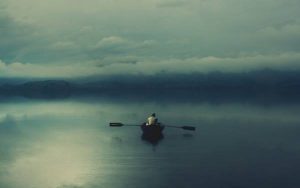 If we give ourselves enough time and loving awareness, our inner turmoil may spend itself out like a long rolling wave unfurling. Every emotion has its own ebb and flow. In riding those waves we come to know ourselves as we live with impermanence and the unknown. As we allow the truth of our experience to be known, we may also realize our inter-relatedness. I am because we are. In time and the kinship of loving awareness, we may come to know what is needed.
If we give ourselves enough time and loving awareness, our inner turmoil may spend itself out like a long rolling wave unfurling. Every emotion has its own ebb and flow. In riding those waves we come to know ourselves as we live with impermanence and the unknown. As we allow the truth of our experience to be known, we may also realize our inter-relatedness. I am because we are. In time and the kinship of loving awareness, we may come to know what is needed.
Today we are navigating life with a great sense of urgency: pandemic, climate change, structural racism, war and waves of refugees around the world. Our simple and profound practice helps us to find stillness and movement. It helps us to be with the truth of our individual, inter-personal and collective experience. Poet Jane Hirshfield describes this slow engagement in her poem, Rebus.
You work with what you are given,
the red clay of grief,
the black clay of stubbornness going on after.
Clay that tastes of care or carelessness,
clay that smells of the bottoms of rivers or dust.
 Each thought is a life you have lived or failed to live,
Each thought is a life you have lived or failed to live,
each word is a dish you have eaten or left on the table.
There are honeys so bitter
no one would willingly choose to take them.
The clay takes them: honey of weariness, honey of vanity,
honey of cruelty, fear.
This rebus—slip and stubbornness,
bottom of river, my own consumed life—
when will I learn to read it
plainly, slowly, uncolored by hope or desire?
Not to understand it, only to see.
 As water given sugar sweetens, given salt grows salty,
As water given sugar sweetens, given salt grows salty,
we become our choices.
Each yes, each no continues,
this one a ladder, that one an anvil or cup.
The ladder leans into its darkness.
The anvil leans into its silence.
The cup sits empty.
How can I enter this question the clay has asked?
This is the work we are given: the humbling way of full attention, creativity and care. At times the “red clay of grief” of the “clay that tastes of care or carelessness.” Our lives unfold in thoughts we choose to bring to life or abandon. The humbling way is perhaps not to understand – but to see the unfolding mystery.
Here we are resting. We are present with what is emerging. This is how we work with what we are given, how we “enter the question the clay has asked.” Insight Dialogue teacher Gregory Kramer reminds us that:
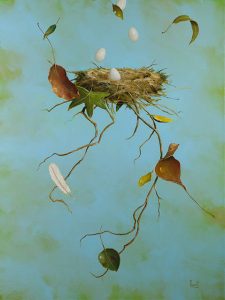 . . . In a world where everything changes, it is clinging that causes pain. Going with the change, simply rest in awareness. Hold the simple question, “What is emerging now?” Let go of imagined control of experience. Remember this guideline and dwell lightly in the moment . . .
. . . In a world where everything changes, it is clinging that causes pain. Going with the change, simply rest in awareness. Hold the simple question, “What is emerging now?” Let go of imagined control of experience. Remember this guideline and dwell lightly in the moment . . .
What is emerging now? Our personal experience is embodied within a network of family, friends, community, the natural world. We are emerging as Life expressing itself in form, feeling, thought and spirit. The ever changing nature of experience is revealed in unpredictable and surprising ways – like the song of a nightingale emerging in beautiful patterns of sound – a vibrating dance carried on air into our ears. The nightingale and his song are briefly held in the clay cup of our awareness. In the wider circle of our practice we can consider the songs we are singing – how they are informed by birdsong and everything else we hear. We can wonder where does our voice travel and whose ears are we touching?
How is it for you to trust this ever unfolding present? Again and again we step into the unknown and we trust. We trust the next incoming breath or sound. We surrender in the quiet moments of our choosing – sometimes in the midst of struggle. Experience dissolves every instant. In loving awareness we begin to appreciate the mystery of what arises and passes away.
Poet Alla Bozarth writes of the clay of which we are made:
The small plot of ground
on which you were born
cannot be expected
to stay forever
the same.
Earth changes,
and home
becomes different
places.
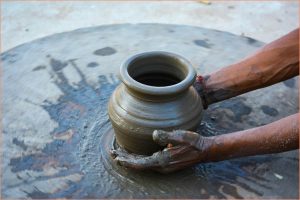 You took flesh
You took flesh
from clay
but the clay
did not come
from just one
place.
To feel alive,
important, and safe,
know your own waters
and hills, but know
more.
You have stars
in your bones
and oceans
in blood.
You have opposing
terrain in each eye.
You belong to the land
and sky of your first cry,
you belong to infinity.

